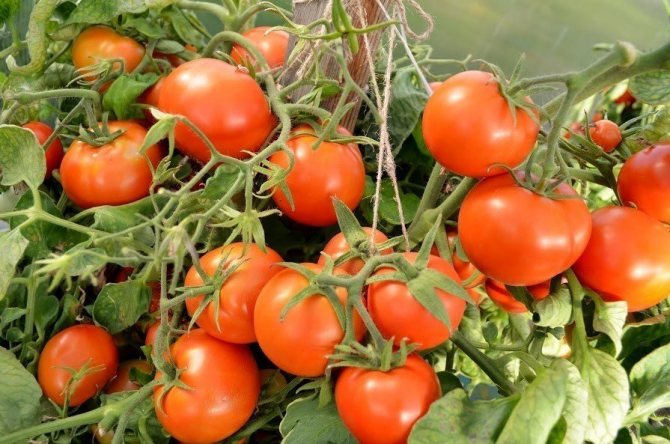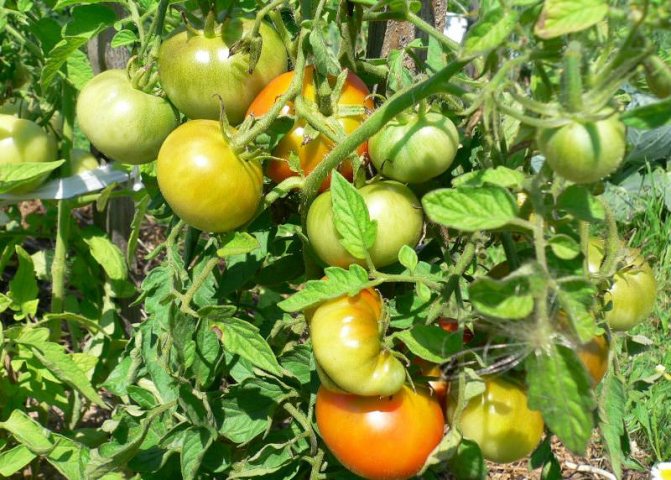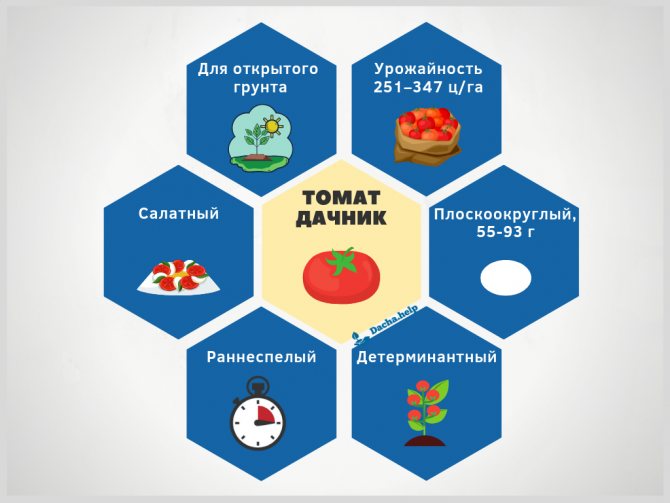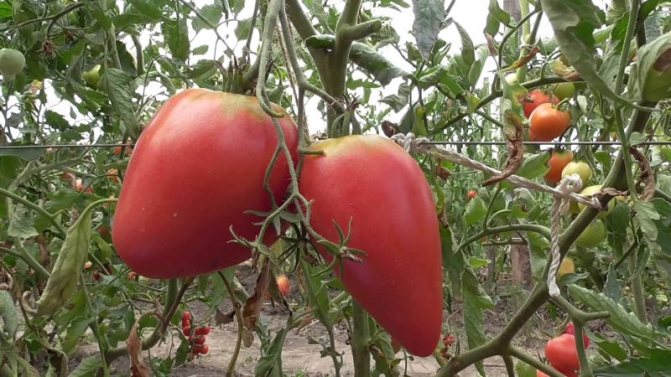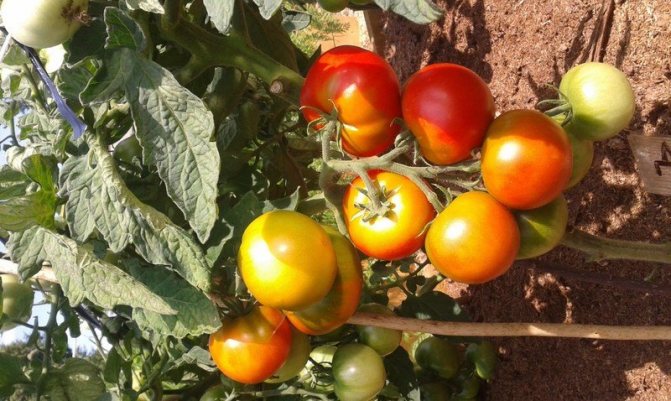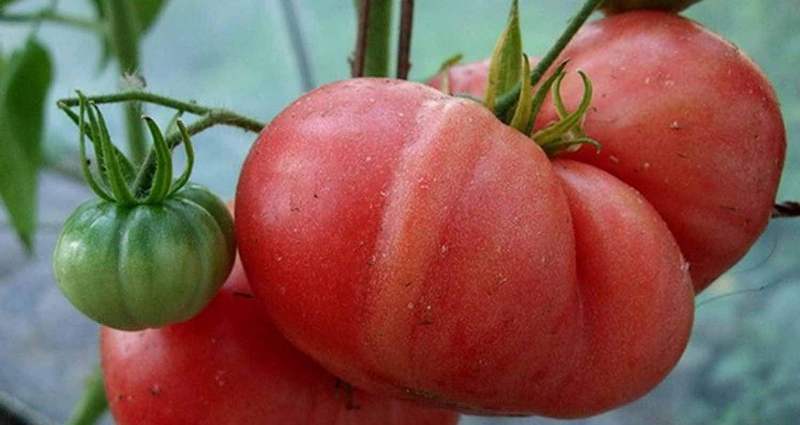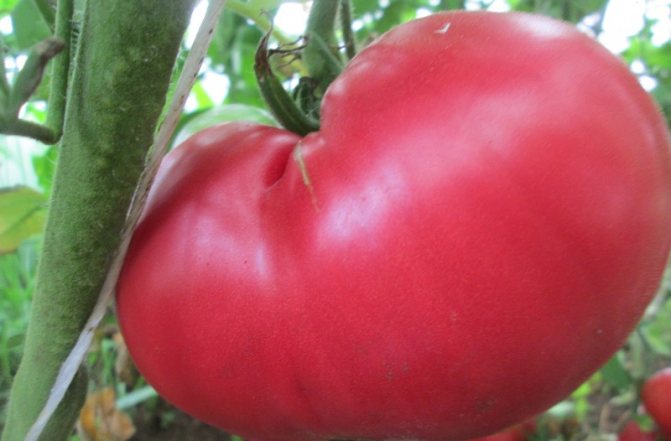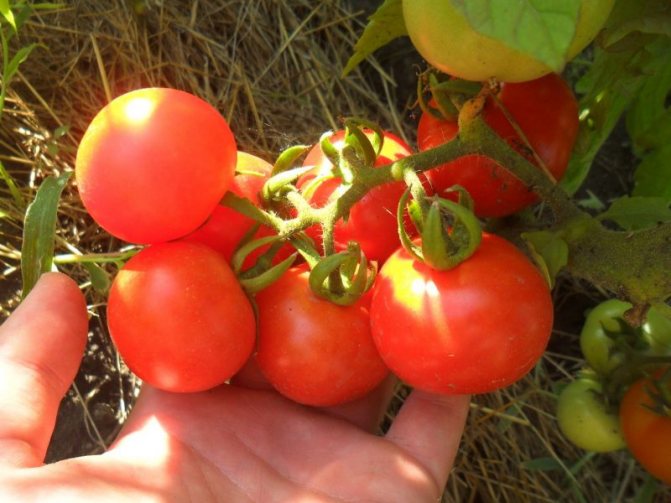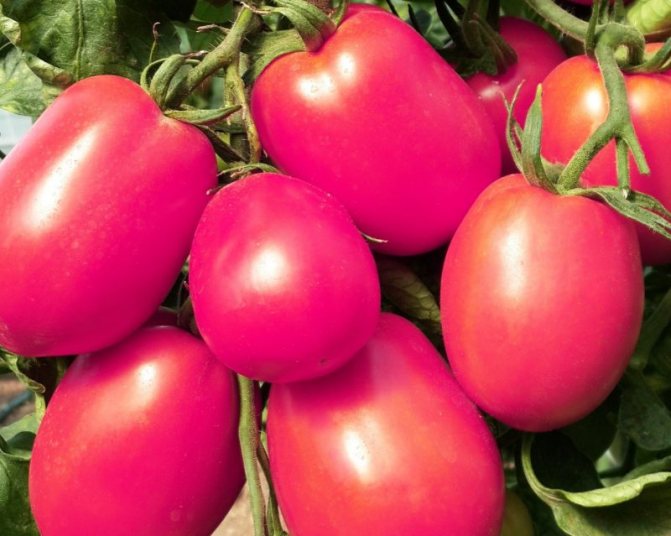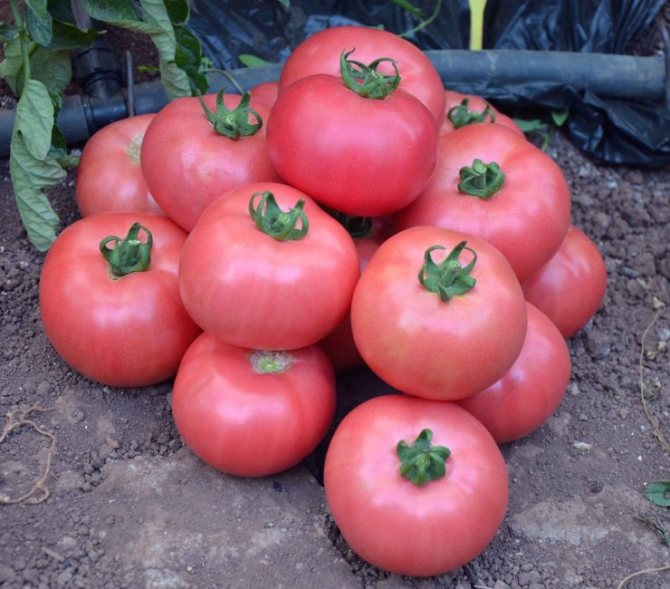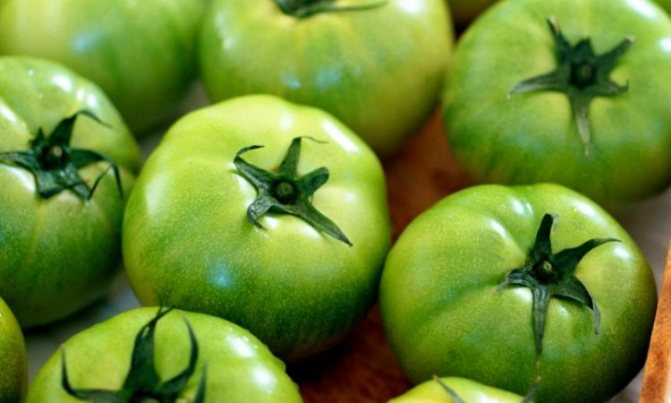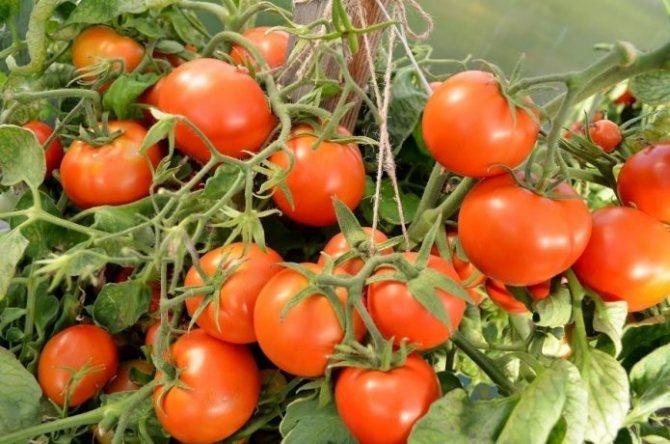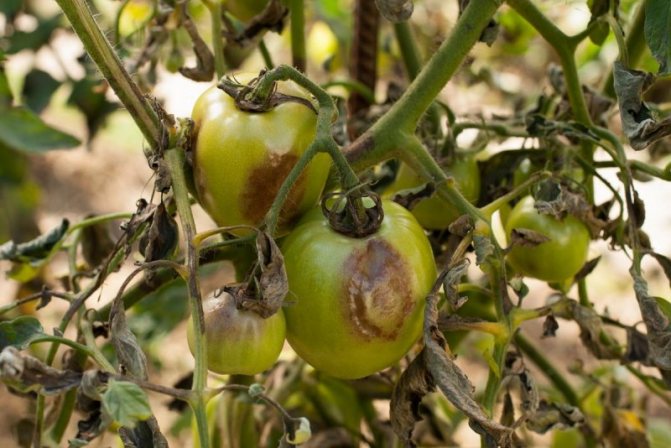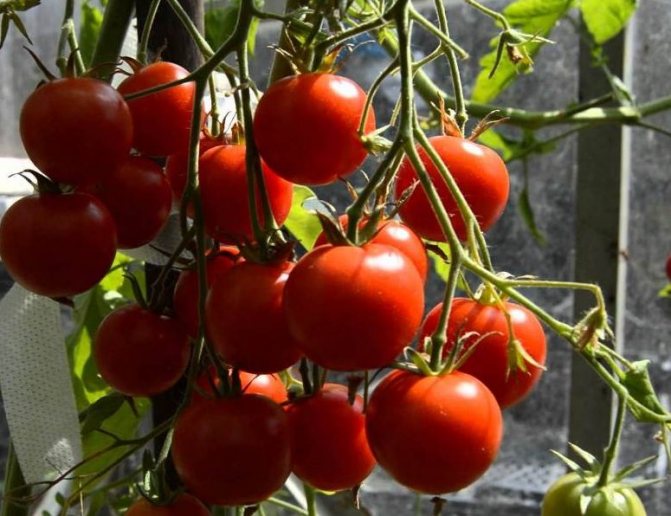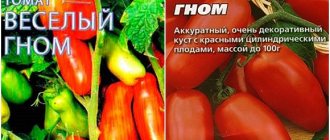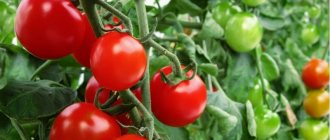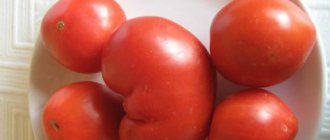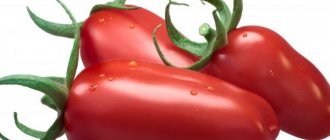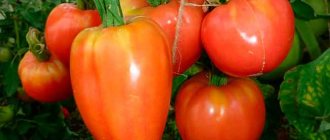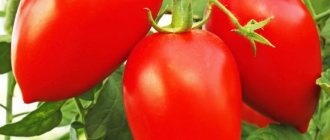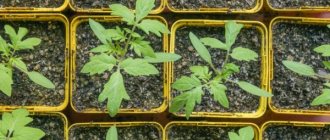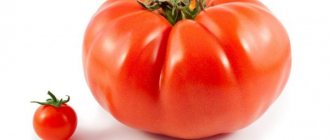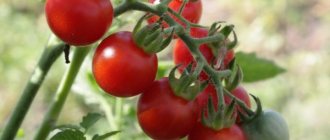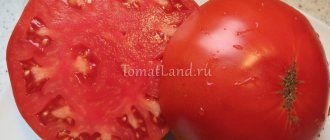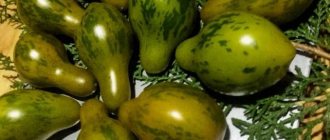Tomato Summer resident is a variety that everyone, without exception, likes. High-yielding and unpretentious, it can provide a full supply of tomatoes and still remain for sale.
| Height | Pick-up location | Ripening terms | Fruit color | Fruit size | Origin | Fruit shape |
| Medium-sized | Greenhouse, Open ground | Early ripe | Red | Middle | Variety | Round |
Tomato Summer resident variety description
| Variety name | Summer resident |
| general description | Early maturing, determinant tomato variety for cultivation in greenhouses, greenhouses and open field |
| Originator | Russia |
| Ripening period | 96-105 days |
| The form | Flat-rounded with slightly pronounced ribbing near the peduncle |
| Color | Red |
| Average weight of tomatoes | 55-110 grams |
| Application | Recommended to be consumed fresh, in the form of mashed potatoes, salads, juice, has shown itself well when canning |
| Variety yield | 3.8-4.2 kilograms per bush |
| Growing features | Standard agricultural technology |
| Disease resistance | resistant to top rot of fruits and fusarium |
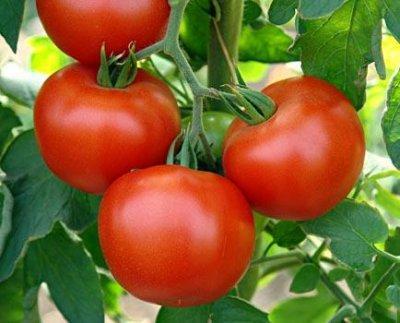
The time from planting seeds to collecting the first ripe fruits is 96-105 days. The bush is of a determinant type, does not exceed a height of 60-70 centimeters when grown in a greenhouse, on open ground, a height of about half a meter. Read about indeterminate varieties here.
Bushes with medium branching, the best results are shown when growing a bush with 3-4 stems. Average number of small leaves, typical for tomato shape, green.
The planted bushes are unpretentious in growing, do not need pinching. Gardeners advise tying plants to a vertical support, there have been cases of bushes lodging under the weight of fruit brushes.
According to numerous reviews of gardeners, the variety stands out for its good ability to form a tomato ovary even in adverse weather conditions.
Possesses high resistance to top rot of fruits and fusarium. Resistance to other diseases of tomatoes is average. Read more on our website about varieties that are resistant to diseases of the nightshade, about typical diseases in greenhouses and how to deal with them.
Reviews of gardeners
The description of the variety does not recommend tying and pinching the bushes, but gardeners argue that these measures are necessary: even the most compact plant needs support to avoid fruit falling off. Tie the bushes to stakes up to 1 m high. It is better to grow a crop in 1-2 stems.
The unpretentiousness of the variety to weather conditions and the positive characteristics of gardeners make the summer resident tomato popular. Gardeners talk about getting a decent harvest even in areas with low temperatures.
Characteristics
Fruit shape: flat-rounded with slightly pronounced ribbing near the stalk. The color is red. Average yield: 3.8-4.2 kilograms per bush, with a planting rate of 7-8 bushes per square meter.
Application: it is recommended to use it fresh, in the form of mashed potatoes, salads, juice, according to the reviews received, it has shown itself well in canning. Average fruit weight: 55-95 grams in open beds, up to 105-110 grams in greenhouses. Good presentation, excellent safety during transportation.
For comparison, the table below shows data on the weight of fruits in other varieties of tomatoes:
| Variety name | Fruit weight |
| Summer resident | 55-110 grams |
| Fat jack | 240-320 grams |
| Premier | 120-180 grams |
| Broody | 90-150 grams |
| Polbig | 100-130 grams |
| Buyan | 100-180 grams |
| Black bunch | 50-70 grams |
| Grapefruit | 600-1000 grams |
| Kostroma | 85-145 grams |
| American ribbed | 300-600 grams |
| The president | 250-300 grams |
Eagle heart
A tomato with the proud name Eagle Heart occupies the bottom line of our top. Everyone who grows these giant tomatoes with an elongated tip, shaped like a heart, leaves only positive reviews about it. Fruit weight reaches 600-800 g, and sometimes up to 1 kg. One such pink-raspberry fleshy "hulk" - and you can feed the whole family with a salad! The tomato pulp is sugary, juicy and sweet.
The variety is determinant, with an average ripening period - in a greenhouse with nutritious soil, the bushes grow up to 170 cm and need to be pinned and tied. Outdoors, they may be slightly lower. But their yield sometimes exceeds 10 kg per bush. For such impressive results, no effort is spared. Moreover, the tomato shows resistance to most diseases, does not lose its shape during transportation and can be stored for up to 3 months.
The bronze "medal" and the 3rd place in the rating is received by the Eagle's beak, which is popular with many tomato growers! The variety is mid-season (110-115 days), semi-determinant - the height of strong bushes reaches 120-150 cm. Competent formation, tying to a trellis and timely pinching will help them develop harmoniously and bear fruit well. Under ideal conditions and with proper agricultural technology, the yield can be up to 8 kg per bush.
"The eagle's beak is the best, I have no competition yet, the leader for today." Olga Nesmeyanova.
The fruits are large, of an unusual shape, with an elongated and curved tip, similar to a beak. On average, they weigh 200-400 g, but some grow up to 800 g. The pulp is dense and juicy, with a sweetish taste.
The variety is resistant to the main diseases of the nightshade - late blight, fusarium and tobacco mosaic virus. Tomatoes tolerate transportation well due to their dense skin; they do not crack when canned.
"I really like the Eagle's Beak !!!" Nina Belevtseva.
The generally recognized and most popular variety of Bull's Heart becomes the absolute leader of the national tomato rating, which has received a record number of votes! A real Senior Tomato in all respects!
The variety is late-ripening - the first fruits (5 pieces in a brush) ripen 120-130 days after germination. In the open field, the yield is from 3 to 5 kg of tomatoes per bush. In a greenhouse, this figure can increase to 12 kg. Determinant type bush - stems grow up to 1.5 m or more. To achieve record yields, do not neglect leaving - timely formation and garter to the support, preventive treatment for late blight - and the harvest will not keep you waiting!
Photo
See below: tomato Summer resident photo
History of origin
The Dachnik variety was bred by breeders of the All-Russian Research Institute of Vegetable Growing (headed by N.S. Gorshkova). The originator of the variety is agro.
Important! Do not confuse the variety of the agro variety of the same name, as well as the Kuban Summer Resident, the Ural Summer Resident varieties. These varieties are not related to the variety Dachnik a / f "Poisk".
As vegetable growers note, the Dachny tomato variety is similar to the Sanka variety.
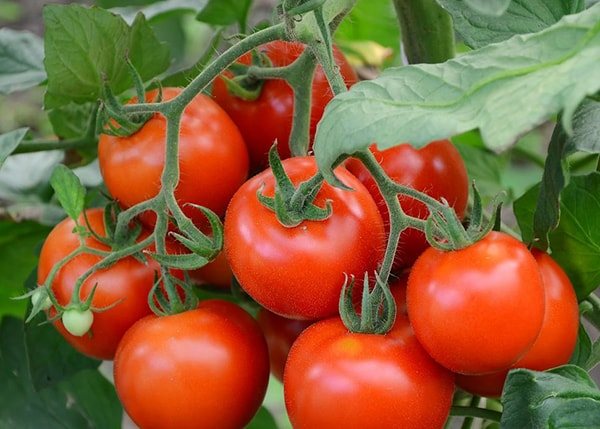

Tomato Summer Resident
Advantages and disadvantages
Dignity varieties:
- early ripening;
- stable yield, not dependent on weather conditions;
- good taste;
- relatively good disease resistance;
- long-term fruiting.
No significant deficiencies were identified... You can check out other high-yielding and disease-resistant varieties here.
You can see the yield of other varieties in the table:
| Variety name | Yield |
| Summer resident | 3.8-4.2 kilograms per bush |
| Olya-la | 20-22 kg per square meter |
| Nastenka | 10-12 kg per square meter |
| King of Kings | 5 kg per bush |
| Banana red | 3 kg per bush |
| Gulliver | 7 kg per bush |
| Brown sugar | 6-7 kg per square meter |
| Lady Shedi | 7.5 kg per square meter |
| Rocket | 6.5 kg per square meter |
| Pink Lady | 25 kg per square meter |
Chio-chio-san
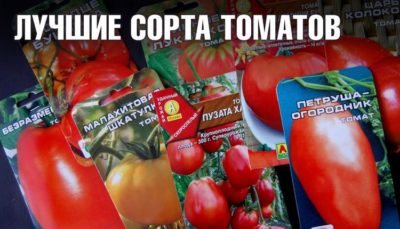

Of the shortcomings of this indeterminate (sometimes it grows up to 2 m) tomato - only the need for a bush in support and formation. The rest is a set of advantages! It is resistant to adverse conditions and can grow even in Siberia and the Far East. It bears fruit well not only in the greenhouse, but also in the open field. It is not afraid of the main diseases of the nightshade.
“In the greenhouse, I am always pleased with the Chio-Chio-san variety from Gavrish. Maria Dolzhikova.
According to the ripening period, the tomato belongs to the medium early - from the appearance of the first shoots to the beginning of fruiting, 100-120 days pass. It will not let you down with the harvest either - although the tomatoes are small (on average about 30-40 g), but they ripen up to 50 pieces. on the brush! So the harvest from a bush with proper care is 4 kg and can reach a record 6 kg. And the taste of this tomato is excellent! And in blanks, it looks very presentable.
“Chio-chio-san - sweet, very productive, tall, with up to 50 smooth, thin-skinned sweet tomatoes in a bunch! Universal for both food and preservation. " Tatiana Vznuzdaeva. Tula region
Growing features
No special delights are required when growing the Dachnik variety. After landing on the ridges, it needs regular watering with warm water.
Excess moisture does not tolerate well... It is advised to remove the bottom 3-4 sheets to improve ventilation. It is necessary to periodically loosen the ground, weed weeds, 2-3 times to feed with mineral fertilizers. You can also use as top dressing: organic matter, iodine, yeast, ammonia, hydrogen peroxide, boric acid.
How to grow
The summer resident is easy to grow and care for. In the southern regions, seeds are sown directly into the ground in May. In mid-latitudes, tomatoes are sown in May in unheated greenhouses, but when the weather is frost-free in June, the bushes are transplanted into open ground.
For 1 sq. m of open ground planted up to 6 tomato bushes. The great advantage of the variety is that it does not require a garter, formation and removal of stepsons. Immediately after planting, water the plant abundantly and mulch with 5-10 cm of straw. This will reduce further watering, which is especially convenient when there is a lack of water or if you are not often at the dacha.
If the bushes fall on the ground under the weight of the fruit, they can all ripen quietly on a straw bed. Moreover, they will not be susceptible to various diseases.
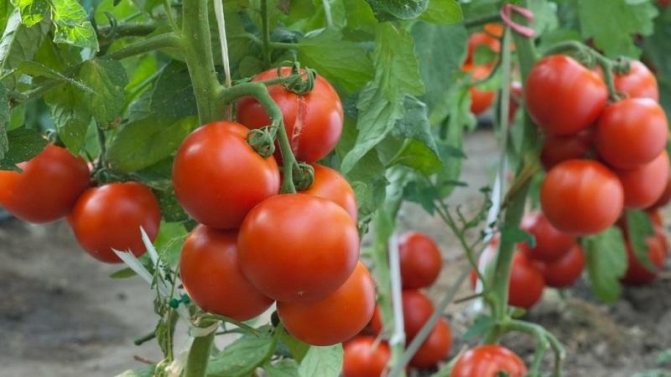

Care features
Plant care is performed as follows:
- Seedlings watered in moderation, without flooding, so that mold does not grow on the ground. Otherwise, the black leg will destroy the plant. After the appearance of the second leaf, a pick is carried out. At the same time, the main root is pinched at the end, then the bush will be strong and strong.
- The land near the stem must be loosened, since it becomes crusty from irrigation. Tomatoes are watered with settled warm water under the plant, in the morning or evening, but not at noon, when it is hot. When it is very stuffy, the seedlings need to be sprayed at the same time.
- Top dressing is carried out as soon as the first ovaries are formed, using diluted manure with clean water in a ratio of 0.5 liters of manure to 10 liters of water. Another 1 tsp is mixed. superphosphate and 1 tsp. potassium sulfate. Top dressing is carried out three weeks after the tomatoes are planted.
- Tomatoes will pick up color faster if the fruits are removed after brown spots appear on them. Indoors, vegetables will ripen quickly. Heavy branches of the bushes are tied up to avoid kinks.
- In mid-August, the plants need to be pinched at the top of the stem and all inflorescences removed. This will speed up the ripening time of fruits that have already set.
- If tomatoes lack nitrogen (leaves turn purple and small), plant 4-5 stem pea bushes around the plant. After 1-2 weeks, the bushes will come to life.
For your information. If the tomatoes are properly planted and properly looked after, the Summer resident will begin to bear fruit before pests and diseases from other crops spread throughout the garden.
Harvesting and storage
The summer resident is distinguished by good preservation of the fruits, but there is always an opportunity to extend the shelf life of tomatoes, and it is foolish not to use it. Harvested tomatoes last longer if kept at the appropriate temperature.
Important! The duration of the preservation of the quality and taste of vegetables depends on the competent preparation of the store and the observance of all the necessary conditions.
Experienced gardeners share the following tips:
- store the harvest of tomatoes in a clean, dried and disinfected room (cellar, basement or refrigerator);
- the most suitable storage temperature is + 10 ... + 12 ° С;
- optimal humidity - 80-85%;
- no light is needed for long-term storage of tomatoes;
- Tomatoes last better and longer if they are harvested unripe.
During storage, the fruits "breathe", releasing moisture, and micro-processes (mold and decay) can develop in them. To avoid this, vegetables are stored in wooden or plastic boxes with their tails up.
Diseases and pests
The variety is highly resistant to top rot of fruits and fusarium.
On our site you will find a lot of useful information on the topic of tomato diseases. Read all about verticillosis, alternaria, late blight and protection measures against it. You can also get acquainted with varieties that are not susceptible to late blight. Correct use of fungicides will help you avoid many problems in your garden, and you can read about them here.
As for pests, the greatest danger to tomatoes is always Colorado beetles, spider mites, bears, slugs. Insecticides will help in the fight against them.
The Dachnik variety, chosen for planting on the site, guarantees the receipt of tomatoes with little care, due to the duration of fruiting, it will allow you to take your time harvesting for the winter.
Puzata khata
In terms of the number of votes won, he did not go far from the Cap of Monomakh. The appearance of these tomatoes fully explains the name. Large (300 g), pear-shaped, ribbed, just like squat houses for gnomes, these tomatoes ripen early - 105-110 days after transplanting. True, they turn red gradually if there is a lot of heat and sun. They are grown in the open field and under a film, where they ripen faster. The fruits are fleshy, very sweet and juicy to the taste.
The bushes are indeterminate, but even in a greenhouse their height rarely exceeds 170 cm.However, it will not be possible to do without formation. The stems are thin and need a garter, as they can lie under the weight of the fruit. And the yield of these tomatoes, ripening in brushes of 3-5 pcs., Show quite decent - 10-11 kg per bush. They are not very susceptible to common cultural diseases, but preventive measures of protection have not prevented anyone yet.
“This year I also want a Puzata hut. Last year they were with a friend - just a miracle! ". Marina Samoilova.

